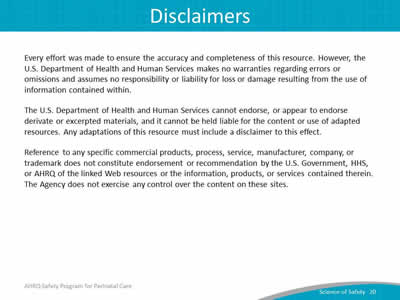Understand the Science of Safety for Perinatal Safety: Facilitator Guide
AHRQ Safety Program for Perinatal Care
Slide 1: Understand the Science of Safety for Perinatal Safety

Say:
The Understand the Science of Safety module of the AHRQ Safety Program for Perinatal Care discusses the importance of understanding system design, safe design principles, and valuing diverse input from team members. By analyzing patient safety as a science, frontline providers will provide a higher quality of patient-centered care on the labor and delivery, or L&D, unit.
Slide 2: Learning Objectives

Say:
In this module, we will—
- Describe the historical and contemporary context of the Science of Safety.
- Explain how system design affects system results.
- List the principles of safe design and identify how they apply to technical work and teamwork.
- Detail how teams make wise decisions when there is diverse and independent input.
Slide 3: Health Care Defects

Say:
Examples of the effect of defects and errors in the U.S. health care system are illustrated on this slide.
- 7 percent of patients suffer from a medication error.
- In 1999, 44,000 to 99,000 people die from medical errors in hospitals each year.
- More recent estimates suggest that between 210,000 and 440,000 patients who go to a hospital each year suffer some type of preventable harm that contributes to their death.
- Over half a million patients develop catheter-associated urinary tract infections, resulting in 13,000 deaths a year.
- Nearly 100,000 patients die from healthcare-associated infections each year, and the cost of these infections is$28 to $33 billion per year.
Slide 4: How Can These Errors Happen?

Say:
Errors occur within the health care setting because health care professionals are human, and humans are fallible. As this illustration shows, a "wet floor" sign may get removed too soon, resulting in an accident.
Providers, executives, and managers need to understand why errors occur. The first step in comprehending why they happen is accepting that people are not perfect. Even the most knowledgeable and experienced provider is influenced by the environment in which he or she works and can be responsible for mistakes that inflict harm to a patient and that patient's family. In understanding and acknowledging this fallibility, individuals can redesign care and delivery processes to improve patient care.
Errors occur because medicine is still treated as an art, not a science.
In analyzing how errors occur, frontline providers must recognize the scientific nature of medicine. By treating medicine and care delivery as a science instead of an art, providers can scrutinize their processes using evidence-based practices. As a result, providers must increase their ability to learn from mistakes and implement procedures to help prevent serious errors from occurring again.
Errors also occur because systems frequently do not catch mistakes before they reach the patient.
Standardizing procedures, such as applying checklists and creating independent assessments for key processes, further aids in the development of high-quality patient care by allowing providers to mitigate risks before a harmful event takes place.
Slide 5: The Science of Safety

Say:
According to the Science of Safety—
- Every system is perfectly designed to achieve its end results. Once all team members, including managers and executives, understand that systems are designed to achieve specific results, they are better prepared to join system improvement activities for reducing patient harm. Being cognizant of the system design and how it contributes to the results that it delivers will help providers adapt their routines and procedures to meet the needs oft he L&D unit.
- In addition, safe design principles must be applied to technical work and teamwork to maximize results. The three principles of safe design are(1) standardize when possible, (2)create independent checks, and (3)learn from defects. The principles of safe design are discussed in more detail later in this module.
- Last, teams make intelligent decisions when provided with diverse and independent input from all team members, reflecting their roles and experience, which supports the relationship between patient safety and system design.
Slide 6: System-Level Factors Affect Safety

Say:
As the illustration shows, at any given time, there are several system factors that simultaneously influence unit culture and patient safety.
Patient characteristics
Patient characteristics, such as medical history, acuity, primary language, or ability to participate in the development of the care plan, can influence patient safety.
Task factors
In addition to patient characteristics, task factors can shape the delivery of care and patient safety in the L&D unit. Patient complexity and acuity influences both the ability of providers to meet patient needs and their capacity to manage the task of care.
Individual provider
Providers should understand the relationship between their own knowledge, skills, and attitudes and how these may affect the quality of care that patients receive. Providers should be comfortable speaking up if they do not agree with task assignments and protocols or when they see patient safety risks. Evidence suggests a direct relationship between some patient outcomes and the willingness of staff to speak up.
Team factors
Team factors may involve issues with teamwork, communication, inadequate supervision, and training.
Work environment
Noisy, dirty, distracting, or poorly lit work environments can wreak havoc on the delivery of high-quality patient care and should be addressed when attempting to diagnose system-level influences on patient care.
Departmental factors
When staffing issues, admission policies, and protocols prove to be insufficient for the needs of the patient and the provider, they will affect the quality of care. Staffing and coverage shortages cause patients to suffer because they do not receive the attention they need. Additionally, staffing and coverage issues increase the likelihood of medication or procedure errors, degrading the type of care the patient receives.
Hospital and institutional factors
The type of facility and budgetary limitations may affect the patient's care plan. While these issues are the furthest removed from the patient in the diagram, these factors continually affect patient care during a hospital stay.
Slide 7: System-Level Factors Can Predict Performance

Say:
When nurse-to-patient ratios exceed best practice based on the unit's acuity and rate of volume change, there is an increased risk of patient complications.
In another example from a team working on a L&D unit, hierarchy issues plagued the unit, disrupting the abilities of the unit nurses and doctors to work together effectively. The nurses were able to alleviate these hierarchical issues by engaging hospital administration with their initiative. With the support of the executive staff at their hospital, the nurses were empowered to enforce the labor induction guidelines set by the facility. This shift of authority led to a significant drop in the number of reported birth complications.
Slide 8: Three Principles of Safe Design

Say:
The three principles of safe design are—
- Standardize when possible.
- Create independent checks.
- Learn from defects.
These principles sculpt the means with which L&D unit CUSP teams are able to scrutinize their environment and the processes to deliver safety patient care.
Standardize when possible
In standardizing procedures, L&D unit CUSP teams are able to alleviate duplications of labor and resources. This in turn will save teams valuable time and energy. Examples include the use of standard administration procedures for oxytocin and magnesium sulfate and the use of standardized terminology for interpreting and communicating results from electronic fetal monitoring staff.
Create independent checks
Independent checks help guarantee the patient receives the highest quality of care possible. Independent checks include checklists, protocols, and preoperative briefs. L&D unit staff are able to focus on patient care and have confidence that any accidental breach in protocol will be caught by a check or team alert when the break in policy or procedure occurs.
Learn from defects
This principle calls for L&D unit teams to evaluate their processes and learn from defects and, when possible, to share what they learn with other similar care settings. When learning from defects, L&D unit teams identify—
- What happened?
- Why did it happen?
- What will we do to reduce the recurrence?
- How will we know it worked?
In determining the defect that occurred, teams reconstruct the timeline of the event by placing themselves in the midst of the incident as it unfolded. Analyzing what happened and why it happened helps the team understand the contributing factors and processes. Through proposing, prioritizing, and implementing solutions, L&D unit teams seek to minimize the chances the defect will reoccur.
L&D unit wide assessment of the effectiveness of the interventions allows the team to ensure effective solutions are sustained, ineffective solutions are revised, and frontline staff members are aware their input is critical to continual quality improvement as embodied by the Learning From Defects exercise.
Slide 9: Standardize When You Can

Do:
Play the video.
https://www.ahrq.gov/hai/cusp/videos/04c-standardize/index.html
Ask:
- What are some ways you standardize work in your unit?
- What has worked well? Why?
- What has not worked well? Why?
Slide 10: Create Independent Checks

Do:
Play the video.
https://www.ahrq.gov/hai/cusp/videos/04d-independent-checks/index.html
Ask:
- What issues did the team experience in its unit?
- How did the team implement independent checks in its unit?
- What are some ways your team carries out independent checks?
Slide 11: Learn From Defects

Do:
Play the video.
https://www.ahrq.gov/hai/cusp/videos/04e-learn-defects/index.html
Say:
Apply these four Learning From Defects questions to this example.
- What happened?
- Why did it happen?
- How will you reduce the risk of recurrence?
- How will you know it worked?
Slide 12: Principles of Safe Design Apply to Technical Work and Teamwork
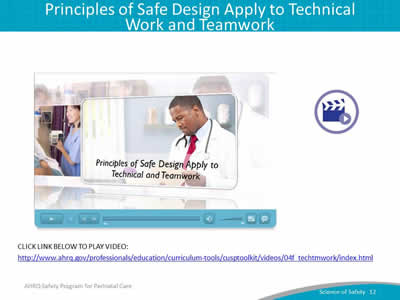
Do:
Play the video.
https://www.ahrq.gov/hai/cusp/videos/04f-tech-teamwork/index.html
Say:
The principles of safe design apply to technical work as well as teamwork.
Slide 13: Teams Make Better Decisions When There Is Diverse and Independent Input
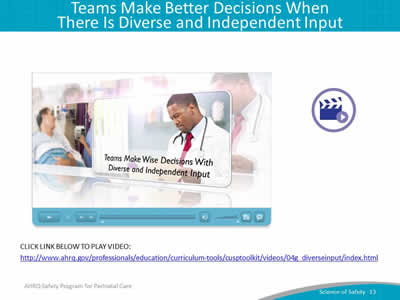
Do:
Play the video.
https://www.ahrq.gov/hai/cusp/videos/04g-diverse-input/index.html
Say:
Teams make better decisions when there is diverse and independent input from unit providers, colleagues, patients, and patients' family members.
Slide 14: How To Ensure Diverse and Independent Input
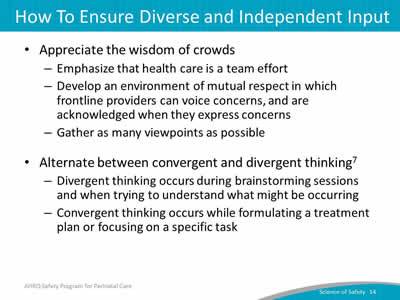
Say:
Providers must remember that health care is a team effort and operates best when all team members are ready, willing, and able to commit to delivering the highest quality patient care. Team members should strive to build an environment of mutual respect in which frontline providers feel comfortable speaking up and having their concerns addressed. The backgrounds, experience, and training of L&D unit staff varies greatly, and incorporating this diversity will prove to be an effective means of delivering high-quality patient care.
Team members need to alternate between convergent and divergent thinking.
Divergent thinking
Divergent thinking includes brainstorming and possibility thinking to explore questions such as—
- What is the patient's current status?
- If there seem to be complications, what might be happening?
- What might be important to consider?
- Did we miss anything?
- What will be the outcome of decisions we make regarding these issues?
Convergent thinking
Convergent thinking asks the team to confer about all the potential problems that have been discussed and collaborate to form a plan of treatment, a plan of care for the day, or a plan to eliminate an identified defect.
Slide 15: Basic Components and Process of Communication
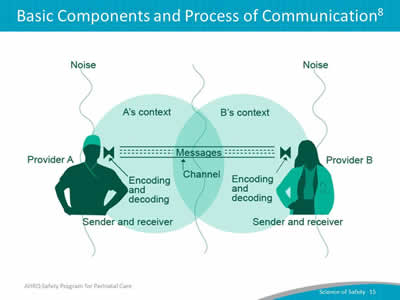
Say:
Communication, in both verbal and nonverbal forms, is complex and subject to distortion and misinterpretation. In verbal communication, ideas are first encoded, or created, when the sender relays a message with meaning to the receiver. The receiver then decodes, or understands, the message received. However, that understanding is affected by the context surrounding the message, noise and other distractions, and the individual makeup of the participants involved in the conversation.
These seemingly insignificant components comprise the overall communication system in which providers share information, ideas, and needs within the health care setting. Each element is interconnected, meaning a distraction or malfunction in encoding or any other component in the model greatly affects decoding and understanding.
The background and physical environment of the communicators influences the distribution and receipt of messages. Being aware of these factors will help units develop environments that facilitate communication and feedback among team members.
Developing supportive environments in which L&D unit staff will be able to discuss ideas, plans, and programs will contribute greatly to the success of the CUSP in the L&D unit.
Slide 16: Understand the Science of Safety: What the Team Must Do
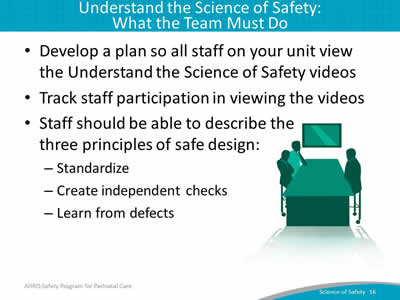
Say:
Develop a plan for all staff on your L&D unit to view the Science of Safety videos. Track staff participation in viewing the videos. Ensure staff can describe the three principles of safe design: standardize, create independent checks, and learn from defect.
Slide 17: Summary
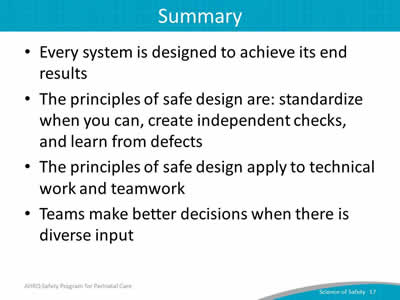
Say:
To review the main components of this module, consider these thoughts:
- Every system is designed to achieve its end results.
- The principles of safe design are standardize when you can, create independent checks, and learn from defects.
- The principles of safe design apply to technical work and teamwork.
- Teams make better decisions when there is diverse input.
Slide 18: References
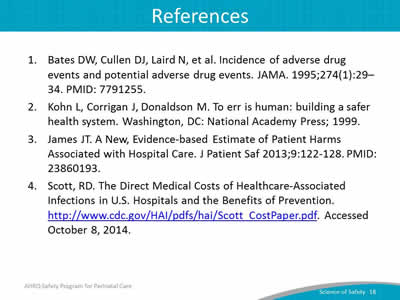
Slide 19: References
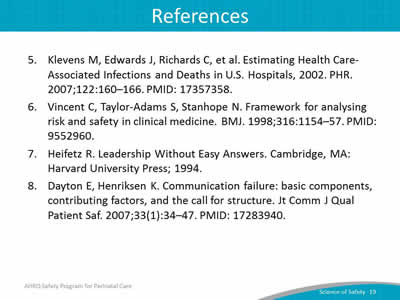
Slide 20: Disclaimers
